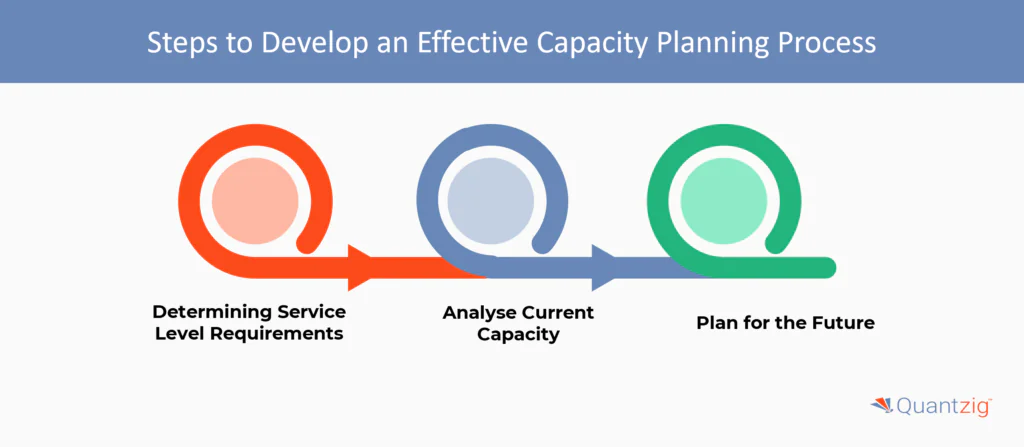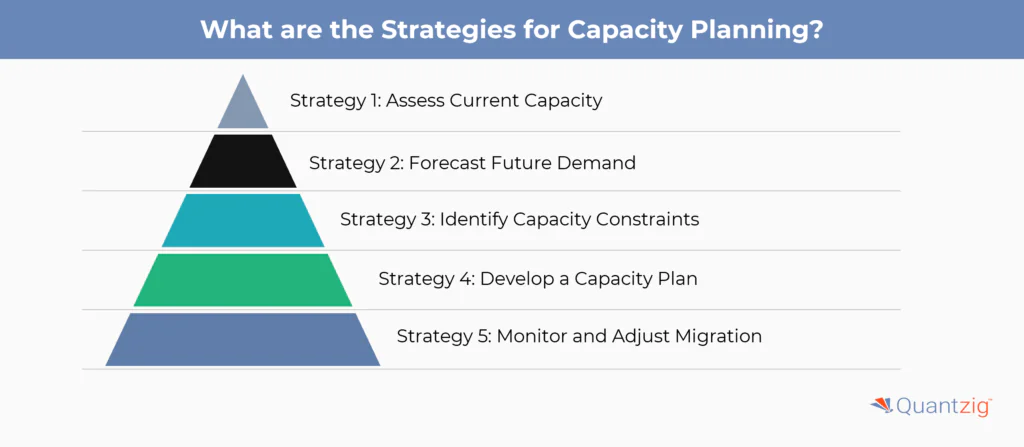Written By: Associate Vice President, Analytics and Data Strategy, Quantzig.
Table of Contents
Introduction to Effective Capacity Planning
Irrespective of the size of the business, every manufacturing company benefits from the financial and logistical capabilities of capacity planning. The capacity planning process is a method of project management that takes into account the efficient use of resources through a projection of production needs. Establishing a proper capacity planning process is essential for companies to maintain workforce and product manufacturing. The capacity planning process does not need to be onerous, but it should involve carefully thought-out steps to ensure that businesses have the right amount and type of resources at the right time. That is why resource planning forms an integral part of the capacity planning process.
In this article, our supply chain analytics experts have laid down a few steps that are critical to developing an effective capacity planning process.
Book a demo to experience the meaningful insights we derive from data through our analytical tools and platform capabilities. Schedule a demo today!
Request a Free DemoWhat is Effective Capacity Planning?
Effective capacity planning is a critical component of any organization’s IT strategy, as it enables businesses to optimize their resources, ensure scalability, and maintain high levels of performance. This strategic approach involves a thorough analysis of an organization’s current and future needs, ensuring that its IT infrastructure is adequately sized and configured to meet the demands of its users and applications. By assessing current capacity, forecasting future demand, identifying capacity constraints, and developing a comprehensive capacity plan, organizations can ensure that their IT resources are utilized efficiently and effectively.
By adopting effective capacity planning, organizations can reap numerous benefits, including improved resource utilization, enhanced scalability, reduced downtime, better decision-making, and increased agility. This strategic approach enables businesses to respond quickly to changing business needs, stay competitive in their market, and drive business success. By prioritizing effective and agile capacity planning, organizations can unlock the full potential of their IT infrastructure and achieve their strategic objectives.
What are the Aspects of Capacity Planning?
Capacity planning metrics involves several key aspects to ensure effective resource management and optimal business performance. These aspects include:
- Assessing Current Capacity: Analyzing the organization’s current IT infrastructure, including servers, storage, network, and applications, to identify areas of inefficiency and potential bottlenecks.
- Forecasting Future Demand: Predicting future demand for IT resources based on historical usage patterns and trends, considering factors such as business growth, new applications, and changes in user behavior.
- Identifying Capacity Constraints: Identifying potential bottlenecks in the IT infrastructure, such as limited storage or network bandwidth, and prioritizing solutions to address these constraints.
- Developing a Capacity Plan: Outlining the necessary upgrades, expansions, or optimizations required to meet future demands, ensuring that the IT infrastructure is adequately sized and configured to meet future needs.
- Monitoring and Adjusting: Continuously monitoring the organization’s IT infrastructure and adjusting the capacity plan as needed to ensure that it remains aligned with changing business needs and that any capacity constraints are addressed promptly.
Steps to Develop an Effective Capacity Planning Process
1. Determining Service Level Requirements
This is the first step in the development of a capacity planning process. In this step, a business needs to break down work into categories and quantify users’ expectations for how that work gets done. This step involves three stages:
- Establishing workloads
- Determining the unit of work
- Setting levels of service
Businesses can organize workloads by specifying either who is doing the work, the type of work performed, or the process of the work. Workloads measure the number of resources needed to accomplish the work, a unit of work helps in measuring the quantity of work completed, and setting service levels helps in laying out acceptable parameters between the provider and the consumer.
2. Analyze Current Capacity
The next step in developing the capacity planning process is to analyze the current capacity of the business operations. Businesses need to analyze their current production schedule for better capacity management. They should analyze each workload by following these four steps:
- By comparing the measurements of any items referenced in service level agreements with their objectives
- Strategic resource planning and checking the usage of every resource of the system
- Analyzing the resource utilization for each workload and identifying workloads that are the primary users of each resource
- Determining points where each workload spends its time and gaining insights into which resource takes the most significant portion of response time for each workload
3. Plan for the Future
This is the final step involved in developing an effective capacity planning process. Once the current capacity is analyzed, businesses need to know the amount of work that is expected to come over the coming quarters. Following this, they need to configure the optimal system for satisfying service levels over this period. The optimal configuration ensures you meet service level requirements and offers an opportunity for companies to optimize their production process and prepare themselves for the future.
Get started with your complimentary trial today and delve into our platform without any obligations. Explore our wide range of customized, consumption driven analytical solutions services built across the analytical maturity levels.
Start your Free Trial TodayWhat are the Strategies for Capacity Planning?
Incorporating capacity planning best practices is a critical component of any organization’s strategy, as it enables businesses to optimize their resources, ensure scalability, and maintain high levels of performance. Effective capacity planning involves a range of strategies that help organizations manage their IT resources efficiently and effectively. Here are five key strategies for effective capacity planning:
Strategy 1: Assess Current Capacity
Assessing current capacity involves analyzing the organization’s current IT infrastructure, including servers, storage, network, and applications. This assessment helps identify areas of inefficiency and potential bottlenecks, enabling organizations to prioritize upgrades and optimizations. By understanding current capacity, organizations can develop a comprehensive capacity plan that meets their future needs.
Strategy 2: Forecast Future Demand
Forecasting future demand involves analyzing historical usage patterns and trends to predict future demand for IT resources. This includes considering factors such as business growth, new applications, and changes in user behavior. By forecasting future demand, organizations can ensure that their IT infrastructure is adequately sized and configured to meet future demands.
Strategy 3: Identify Capacity Constraints
Identifying capacity constraints involves identifying potential bottlenecks in the IT infrastructure, such as limited storage or network bandwidth. By identifying these constraints, organizations can prioritize solutions to address these constraints, ensuring that their IT infrastructure is optimized for performance.
Strategy 4: Develop a Capacity Plan
Developing a capacity plan involves outlining the necessary upgrades, expansions, or optimizations required to meet future demands. This plan should be based on the assessment of current capacity and forecasting of future demand. By having a comprehensive capacity plan, organizations can ensure that their IT infrastructure is adequately sized and configured to meet future demands.
Strategy 5: Monitor and Adjust
Monitoring and adjusting effective capacity management and capacity planning techniques involves continuously monitoring the organization’s IT infrastructure and adjusting the capacity plan as needed. This ensures that the IT infrastructure remains aligned with changing business needs and that any capacity constraints are addressed promptly. By monitoring and adjusting, organizations can ensure that their IT infrastructure remains optimized for performance and scalability.
Effective capacity planning strategies is critical for organizations seeking to optimize their IT resources, ensure scalability, and maintain high levels of performance. By adopting these five strategies, organizations can ensure that their IT infrastructure is adequately sized and configured to meet future demands, enabling them to respond quickly to changing business needs and stay competitive in their market.
Experience the advantages firsthand by testing a customized complimentary pilot designed to address your specific requirements. Pilot studies are non-committal in nature.
Request a Free PilotConclusion
An effective capacity planning process is crucial for businesses to meet market demands efficiently. By leveraging demand forecasting and capacity planning, big data and artificial intelligence for accurate forecasting, companies can align their factors of production with market demand. This involves developing a robust production planning strategy and optimizing the supply chain. Proper data management and the optimization of roles and skills are essential for scaling operations and mitigating business risk. Understanding the nature of business and its unique requirements ensures that resources are used effectively, leading to enhanced productivity and sustained growth.






